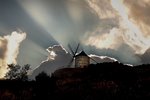What is bullfighting? Will you go to one? Bullfighting is not a sport, but rather an art. It a cross between ballet and theatre. The truth is that, even in Spain now, there is an animal rights movement against it. It is not for everyone, that´s for sure. Let me tell you about bullfighting and you can decide for yourself.
The spectacle is very exciting to see. The colors, the music, the people, the danger,--all of it keeps you on the edge of your seat---if it is well done. The top bullring in the world is in Madrid. A torero (NOT toreador!) has reached the top when he fights there. It´s called Plaza de Toros Las Ventas. There is a Metro stop there. In the bullfight there are 3 parts called tercios or suertes. El tercio de varas, when the picador fights the bull on horseback; el tercio de banderillas, when the banderillero runs and attacks the bull with decorated sticks; and el tercio de la muerte, when death takes place--usually the bull dies, but sometimes the torero dies as well. The valor of the bullfighter is on display with great bravado and provocative macho posing. He risks his life to overcome the danger posed by the bull and the consequent risk of death. It is, in a stylized way, overcoming death.
Death is omnipresent in Hispanic society. People are not embarrassed or troubled by talking about it. This is a major cultural difference from Anglo-Saxon culture, which avoids all mention of death whenever possible. Spain is, after all, the land of Seneca, the Roman Stoic philosopher. It is the acceptance of one´s lot in life.
Contradicting this philosophy is the Spanish flair for public display--speaking loudly, wearing what Anglos would consider too much make-up and jewelry, and general ostentation. All of this is embodied in the bullfight. There have been fighting bulls in Iberia since pre-history. Bullfighting takes place in many countries, and in some of them the bull is spared.
One really beautiful version is a rejoneador fight when the torero is on horseback. Bullfighting, or el toreo, is the subject of much literature--in all genres, but particularly poetry where the bull symbolizes destiny. It is also the subject of the plastic arts, like painting and scuplture.
Pablo Picasso´s famous painting, Guernica, uses a bull in this protest against the Civil War in Spain (1936-1939). Now that Franco is dead, the painting is located in Madrid (It had been temporarily housed at the MOMA in New York. That is where I first saw it. I hadn´t seen it again until years later--last year--in Madrid. It continued to be impressive for me), in the Museo Reina Sofía, a MUST-SEE for anyone going to Madrid:
http://en.wikipedia.org/wiki/Guernica_(painting)
Here is a good overview of bullfighting:
http://en.wikipedia.org/wiki/Bullfighting
Saturday, June 23, 2007
Subscribe to:
Post Comments (Atom)


No comments:
Post a Comment